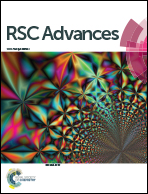Polytriazole bridged with 2,5-diphenyl-1,3,4-oxadiazole moieties: a highly sensitive and selective fluorescence chemosensor for Ag+†
Abstract
Fluorescent conjugated polytriazoles (FCP 1–4) containing both 2,5-diphenyl-1,3,5-oxadiazole (OXD) and 1,2,3-triazole moieties in the main chain were synthesized from aromatic diazide (1) and dialkynes (2–5) via click polymerization, respectively. In the polymers, OXDs (fluorophores) and triazole rings (generated via CuAAC acting as metal ion ligands) comprise a fluorescent system. The polytriazoles displayed relatively strong emission with quantum yields in the range of 0.20–0.28 at room temperature in DMF. The study on their ion-responsive properties showed that, although all four FCPs have good selectivity for Ag+, the integration of alkoxy side groups (methoxy for FCP 2, hexyloxy for FCP 3 and 2-ethylhexyloxy for FCP 4) to the main chains of the polytriazoles decreased their sensitivity for Ag+ via alteration of the polymer aggregation status and electron density of the main chains. Thus FCP 1 is highly sensitive for Ag+, where its Ksv is as high as 1.44 × 105 M−1 and its lowest detection limit is in the ppb range (4.22 × 10−7 M). This study provides an efficient click approach to the synthesis of a novel fluorescence sensor for Ag+ detection, which could expand the application of click polymerization in designing fluorescence sensors based on the triazole unit.


 Please wait while we load your content...
Please wait while we load your content...